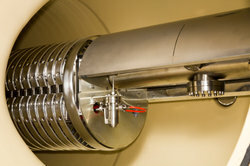How does a synchrotron work?
A synchrotron is a particle accelerator for the highest energies and is therefore mostly found in large research facilities. Electric fields accelerate the particles, magnetic fields keep them on a ring course. But how does it work so precisely coordinated?

This is how a synchrotron is constructed
- In principle, a synchrotron is a circular resp. Ring accelerator. The particles to be accelerated (electrons or protons, for example) run through innumerable predetermined circular paths Male - in contrast to a linear accelerator or a betatron, in which the circular path changes with increasing acceleration enlarged.
- The particles are guided on a fixed circular path with the aid of magnetic fields (keyword: Lorentz force; see below).
- The particles are accelerated by high-frequency fields that are located at regular intervals in the circular ring. The frequency of these fields is - as the name "synchrotron" suggests - increased synchronously with the particle circulation. Put simply, the particles receive a precisely fitting push from the electrical field of the high frequency.
- The particle flow is pre-accelerated by a (small) linear accelerator before it is fed into the synchrotron ring with the help of control magnets. The acceleration usually takes place in so-called. Particle packets.
- A synchrotron can be used to store and experiment with the accelerated particle packets, for example at previously defined points in the circular ring.
The Lorentz force is a force on charged bodies that fly through a magnetic field. …
Equilibria and resonance conditions - this is how it works
But how does it work? In principle, two boundary conditions apply to the successful acceleration of particles in a synchrotron:
- In order to keep the particles on the circular path with radius R, the centripetal force (called centrifugal force in colloquial language) must be in the magnetic field at every moment of the directing Lorentz force.
- The following applies: mv² / R = Q*v*B with m = mass of the particles, v = velocity of the particles, Q = charge of the particles and B = magnetic flux density.
- The correct acceleration timing only works, of course, if the frequency of the electric field is equal to the orbital frequency of the particle packet.
- During operation, both the strength of the magnetic field and the frequency must therefore increase in the course of the acceleration. This process can be carried out with preprogrammed sequences or achieve corrective action.
- Electrons can be accelerated relatively quickly to almost the speed of light with a synchrotron (note the relativistic increase in mass). Protons reach energies far more than GeV.
- There are important synchrotron systems at DESY in Hamburg, at CERN in Geneva and BESSY in Berlin. And FAIR at the Darmstadt GSI is the new future project that is currently being built.
By the way: electrons that are forced onto a circular ring in this way give off some of them energy as so-called Synchrotron radiation, a very high-energy X-ray radiation depending on the acceleration, which is suitable for many examinations. This energy-consuming by-product is therefore quite desirable.
How helpful do you find this article?

